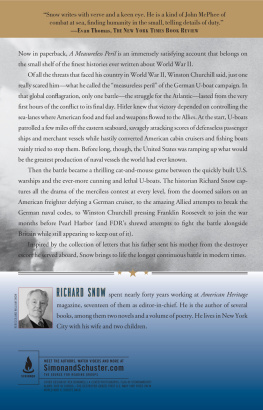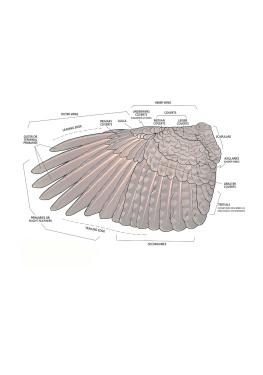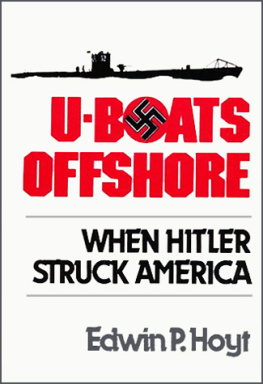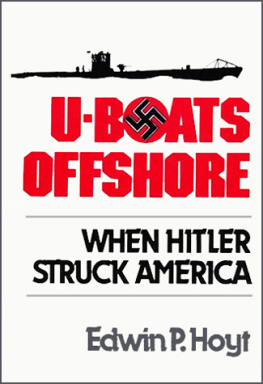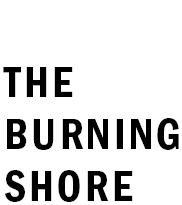

Copyright 2014 by Ed Offley
Published by Basic Books,
A Member of the Perseus Books Group
All rights reserved. No part of this book may be reproduced in any manner whatsoever without written permission except in the case of brief quotations embodied in critical articles and reviews. For information, address Basic Books, 250 West 57th Street, 15th Floor, New York, NY 10107.
Books published by Basic Books are available at special discounts for bulk purchases in the United States by corporations, institutions, and other organizations. For more information, please contact the Special Markets Department at the Perseus Books Group, 2300 Chestnut Street, Suite 200, Philadelphia, PA 19103, or call (800) 810-4145, ext. 5000, or e-mail .
Designed by Pauline Brown
Typeset in 12.25 point Goudy Old Style
Library of Congress Cataloging-in-Publication Data
Offley, Edward.
The burning shore : how Hitlers U-boats brought World War II to America / Ed Offley.
pages cm
Includes bibliographical references and index.
ISBN 978-0-465-08069-4 (e-book) 1. World War, 19391945Naval operations, German. 2. World War, 19391945Naval operationsSubmarine. 3. World War, 19391945Atlantic Coast (U.S.) 4. World War, 19391945CampaignsAtlantic Ocean. 5. Submarines (Ships)GermanyHistory20th century. 6. Submarines (Ships)Atlantic Coast (U.S.)History20th century. 7. Atlantic Coast (U.S.)History, Naval20th century. I. Title.
D781.O44 2014
940.54'51dc23
2013038412
10 9 8 7 6 5 4 3 2 1
This book is dedicated to
John Shearer Tuck
Staff Sergeant USAAF
October 13, 1917November 14, 2012
A member of the Greatest Generation,
a loving father, and a cherished friend
CONTENTS
V IEWED FROM THE AIR, THE NORTH CAROLINA COAST WOULD not have resembled a major battlefield. Yet, as the sun climbed above the eastern horizon, bathing the pine scrub forests and inland waterways in a brilliant orange light, a brutal and desperate struggle was raging just offshore. On Tuesday, July 9, 1942, the area was a critical combat theater of World War II, as it had been for the past six months.
A confluence of factors had made this intersection of land and ocean the fulcrum of the ongoing naval confrontation between Nazi Germany and the Western Allies, a vicious maritime clash now known as the Battle of the Atlantic. By July 1942, the combatants had expanded beyond the British Empire and Nazi Germany. Americas entry into the war against Germany on December 11, 1941, had thrown the US military into the fray. In turn, Hitlers Ubootwaffe, or U-boat Force, initiated an all-out war against American merchant shipping. Vizeadmiral (Vice Admiral) Karl Dnitz, commander-in-chief of the U-boat Force, aimed to win a guerre de course against the Western Allies, sinking their merchant ships at a rate faster than new construction could replace them. Aware that American supplies were
Beginning in early 1942, Germanys U-boat forces had shifted their operations from the mid-Atlantic to the American coastline, where Allied merchant vessels steamed as they took on supplies in East Coast ports or proceeded from the Caribbean with cargos for England. Each day, scores of merchantmen traveled independently through those unprotected waters. Between the Newfoundland Grand Banks and the shallow waters off Florida, the richest hunting ground for the U-boats was the expanse of Atlantic Ocean off the North Carolina coast.
In the waters off Cape Hatteras, climate, geography, and ocean currents combined to create a bottleneck through which merchant ships had to pass as they steamed along the coast. Several dozen miles out from the string of barrier islands known as the Outer Banks, the Gulf Stream constantly flows north from warmer latitudes. Driven by prevailing westerlies and fed by saltwater currents emerging from the Caribbean and West Indies, this river of warmer water, usually about sixty miles wide and 4,000 feet deep, powers along the eastern seaboard at an average speed of five nautical miles per hour. When it reaches Cape Hatteras, about halfway down the Outer Banks, the Gulf Stream collides with the colder waters of the southerly Labrador Current, producing fog, extreme waves, and frequent storms.
U-boat commanders loved Cape Hatteras for a second reason. The underwater topography along the North Carolina coast provided protection that greatly offset the World War IIera U-boats one serious weakness. Powered by diesel engines on the surface and battery-driven electric motors while submerged, the U-boats in 1942 were extremely vulnerable to detection by aircraft and sonar-equipped warships when operating in shallow waters. While the continental shelf is over a hundred miles wide off the mid-Atlantic states and Florida, making it difficult for U-boats to operate there with any degree of secrecy, off Cape Hatteras the seabed quickly drops to several hundred feet in just a couple dozen miles to the east, creating a readily accessible hiding spot during the dangerous daylight hours. The deepwater haven served the U-boats well. By July 7, U-boats operating off the Outer Banks had sunk forty-five merchant ships totaling 262,137 gross registered tons.
In the first half of 1942, the Allies had suffered a devastating and prolonged defeat in the western Atlantic. Plagued by shortages of aircraft and warships and hobbled by poor training and inferior weaponry, the US Navy and US Army Air Forces (USAAF) achieved scant results in their effort to halt U-boat attacks on merchant ships. Thus far in the Battle of the Atlantic, Germany had lost only four U-boats and 161 submariners in North American coastal waters. In a desperate move, the US Navy and
IN RESPONSE TO THE U-BOATS LURKING OFFSHORE, US military planners had selected the new Marine Corps Air Station Cherry Point in eastern North Carolina as a temporary base for antisubmarine patrols. Although the base was still a construction site, the crisis in the Atlantic necessitated an ad hoc response. Cherry Points location between Hampton Roads, Virginia, to the north and Charleston, South Carolina, farther down the coast, meant that aircraft from the base could cover the entire Outer Banks region. Initially, the navy and USAAF sent a number of observation and scouting squadrons to Cherry Point on temporary patrol duty, but their unarmed, short-range SOC-3 Seagull amphibian biplanes and O-52 Owl observation aircraft posed no threat to the U-boats. However, in mid-May, the Army Air Forces dispatched the first of a series of light bomber units to North Carolina that flew A-20 Havoc, B-18 Bolo, or A-29 Hudson bombers. With this new combat capability, planners devised a daily cycle of three antisubmarine patrols, each conducted by two bombers. The flights followed the same pattern. After reaching a separation point twenty-five miles offshore, one aircraft flew parallel to the shoreline up to Hampton Roads, while the second proceeded southwest parallel to the coastline until reaching Charleston. Each mission lasted five hours, with the three patrols overlapping to ensure no gap in coverage.

Next page

